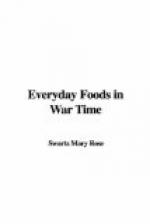However taste be accounted for, we have to recognize the fact that food is chosen for flavor more than for ultimate benefit. It is one thing to say that oatmeal is more nutritious than bread and coffee; it is quite another to induce a man to give up the latter for the former! And yet the distinguishing characteristic of man is that he can subjugate his immediate impulses for his future benefit, or find a course that will harmonize the two—take coffee with his oatmeal for instance, or find some way to flavor it, perhaps with sugar.
Probably no one flavor is so universally enjoyed as sweetness. “Sweeter than the honey in the honey comb” is an ancient symbol of appreciation. When the sugar bowl is empty how many things lose zest! Tea, coffee, cocoa, breakfast cereals, fruit, might still be acceptable, but cake, pie, and ice cream are unthinkable without sweetness; the soda fountain, the bakery, and the candy shop bear further testimony to our love of sweets. Four million tons of sugar a year for the American people—eighty-five pounds apiece, nearly a quarter of a pound apiece daily—this is no inconsiderable amount of flavoring!
But is not sugar good food? Most assuredly. Three lumps of sugar would furnish the extra energy needed to walk a mile; a quarter of a pound represents about one-sixth of a man’s daily fuel requirement. But one baked potato would furnish the same energy as the three lumps of sugar; a quarter of a pound of cornstarch would supply the same fuel as the quarter pound of sugar. Nutritionally starch and sugar are interchangeable, the advantage as far as digestion is concerned being with the starch rather than the sugar. And yet we put sugar on starch! So much for instinct being a guide to scientific food combinations!
The problem of doing without sugar is primarily a problem of flavor—a problem of finding something else which is sweet. Hence we turn our cornstarch into glucose (make corn syrup, for example) outside the body instead of inside it, so that we can taste the sweetness as it goes down. The main trouble with this kind of sugar is that it is not sweet enough to satisfy us and we are apt to use too much, thus endangering our digestions by sheer concentration of what would be, in smaller quantities, most wholesome. Once more we see that nutrition is largely a question of how much; how much glucose or other sugar our stomachs can stand we find out by experience; few stomachs can stand when empty the quantity represented by a lollipop, and yet we frequently see children allowed to suck these between meals. The same amount of sugar diluted with water, as in a glass of lemonade, would do less harm; it might be combined with flour in a cooky with more impunity; better yet, it might be made a part of a whole meal, taking it in several dishes (sauce, dessert, etc.), or, if we must have it as candy, at the end of the meal. Used in this way, the advantages of sugar as a food may be had with relatively little disadvantage.




